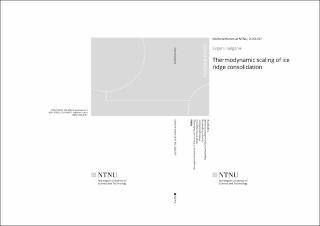| dc.contributor.advisor | Høyland, Knut Vilhelm | |
| dc.contributor.advisor | Marchenko, Alexey | |
| dc.contributor.advisor | Shestov, Alexey | |
| dc.contributor.author | Salganik, Evgenii | |
| dc.date.accessioned | 2020-09-23T09:02:55Z | |
| dc.date.available | 2020-09-23T09:02:55Z | |
| dc.date.issued | 2020 | |
| dc.identifier.isbn | 978-82-326-4943-3 | |
| dc.identifier.issn | 1503-8181 | |
| dc.identifier.uri | https://hdl.handle.net/11250/2679182 | |
| dc.description.abstract | Laboratory and field experiments together with analytical and numerical simulations were performed to study the scaling of the ice ridge consolidation. Such experiments and corresponding thermodynamic models are an important method for describing and predicting morphological, physical, and mechanical properties of the consolidated layer, corresponding atmospheric heat fluxes, and structural loads.
The laboratory-scale experiments covered ice ridges, grown from freshwater, seawater, and water-ethanol solution with different types of morphology including with parallel blocks. Such morphology was used to decrease effects from the ridge inhomogeneity, and to increase the measurement accuracy of the ridge macroporosity and the ice thickness. This allowed for separate investigations of the effects from the other ridge parameters including block thickness, ice initial temperature, and the ridge sail height. The effect of the faster growth rate of the consolidated layer over the level ice for small-scale ridges observed experimentally was found to be related to the difference in convective-conductive coupling for the two types of ice, which can be increased by the extended ridge sail surfaces. The experiments with water-ethanol ice showed no significant difference in consolidation rates with the freshwater ice ridges.
The full-scale experiments covered saline ice ridges artificially made from the surrounding level ice. This method allowed us to increase the accuracy of the macroporosity and initial ice temperature values. The results of the field measurements confirmed the thickness overestimation based on the measured temperature profile in the ridge blocks in comparison to the ridge voids. This thickness overestimation was also observed in small-scale experiments. The effect of slower consolidation rates for the full-scale ridges during the initial phase observed experimentally was found to be related to the significant deviation of those ridges from the homogeneous approach.
Simulations of the ridge consolidation were performed using a two-dimensional finite element method with the moving boundary and the discrete rubble blocks. It was validated by the performed laboratory and field experiments for different scales and different types of ice. It allowed deeper investigations of the effects from the ridge sail, rubble block initial temperature and thickness, ridge keel, and the thickness estimation methods for the consolidated layer. It has also been able to describe the scale-effects in the previous ridge experiments. The simulations helped to provide insight into the analysis of the ice ridge thermal investigations, the estimation algorithms for the consolidated layer thickness, and on the distribution of the heat transfer through the different ridge parts. The difference between fresh and saline ice growth was equally important for level ice and ice ridges, but its values were becoming significant during the initial and warming phases.
The analytical model of ridge consolidation was also formulated and validated using numerical simulations, field, and laboratory experiments. This model also allows to consider sail height, block thickness, initial ice temperature, ice salinity, and snow thickness, but cannot consider the thermal inertia. This analytical ridge model could be used for the prediction of the consolidated layer thickness in the probabilistic analysis of ice actions on structures. | en_US |
| dc.language.iso | eng | en_US |
| dc.publisher | NTNU | en_US |
| dc.relation.ispartofseries | Doctoral theses at NTNU;2020:297 | |
| dc.relation.haspart | Paper 1: Salganik, Evgenii; Høyland, Knut Vilhelm; Shestov, Aleksey. Thermodynamics and consolidation of ice ridges for laboratory scale. Proceedings - International Conference on Port and Ocean Engineering under Arctic Conditions 2017 | en_US |
| dc.relation.haspart | Paper 2: Salganik, Evgenii; Høyland, Knut Vilhelm. Thermodynamics and Consolidation of Fresh Ice Ridges for Different Scale and Configuration. I: Proceedings of the 24th IAHR International Symposium on Ice Vladivostok, Russia June 4-9, 2018. IAHR International Symposium on Ice 2018 | en_US |
| dc.relation.haspart | Paper 3:
Salganik, Evgenii; Høyland, Knut Vilhelm; Shestov, Aleksey; Løset, Sveinung; Heijkoop, Anne-Niekolai.
Medium-scale consolidation of artificial ice ridge – Part I: surface temperature, thickness and mechanical properties. Proceedings - International Conference on Port and Ocean Engineering under Arctic Conditions 2019 ;Volum 2019-June. | en_US |
| dc.relation.haspart | Paper 4: Salganik, Evgenii; Høyland, Knut Vilhelm; Maus, Sønke. Consolidation of fresh ice ridges for different scales. Cold Regions Science and Technology 2020 ;Volum 171
https://doi.org/10.1016/j.coldregions.2019.102959
This is an open access article under the CC BY license | en_US |
| dc.relation.haspart | Paper 5: Salganik, E., Høyland, K.V., Shestov, A. Medium-scale experiment in consolidation of an artificial sea ice ridge in Van Mijenfjorden, Spitsbergen.
The final published article is available in Cold Regions Science and Technology
Volume 181
https://doi.org/10.1016/j.coldregions.2020.103194
This is an open access article under the CC BY license | en_US |
| dc.title | Thermodynamic scaling of ice ridge consolidation | en_US |
| dc.type | Doctoral thesis | en_US |
| dc.subject.nsi | VDP::Technology: 500::Environmental engineering: 610 | en_US |
